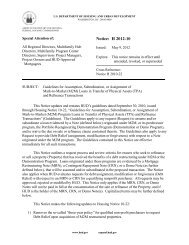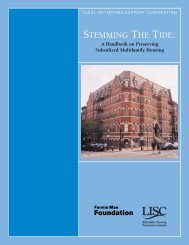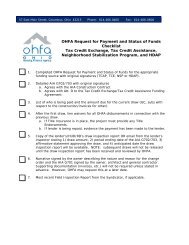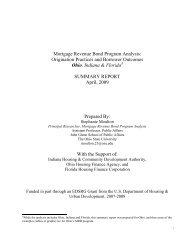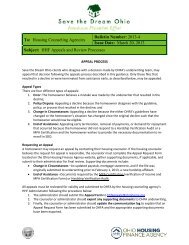OHFA Annual Plan - Ohio Housing Finance Agency
OHFA Annual Plan - Ohio Housing Finance Agency
OHFA Annual Plan - Ohio Housing Finance Agency
Create successful ePaper yourself
Turn your PDF publications into a flip-book with our unique Google optimized e-Paper software.
4) Several cities in <strong>Ohio</strong> currently have land banks, including Cleveland and Columbus.However, these land banks have not historically accepted structures into their land banks,but instead have focused on vacant land.5) City revenues: Cities are currently using local tax dollars to board and demolish homes,maintain grass cutting, monitor code violations and respond to crime and emergency callsthat result from activity in and around vacant housing. These funds, as documented byReBuild <strong>Ohio</strong>, are inadequate to this task given the high number of vacant homes resultingfrom foreclosures, population loss, job losses and obsolescence.6) Local vacant housing collaborations: These exist in Cleveland, Cincinnati, Toledo as othercities in <strong>Ohio</strong>. They generally involve a diverse group of stakeholders and have the backingof both city and county. <strong>OHFA</strong> is currently providing support for a major collaboration inCleveland.Unmet needs:Demolition and Rehabilitation: While cities within weak markets find an overabundanceof housing supply, including affordable housing, other stronger market cities risk eliminatinghigh demand affordable housing units due to the cost discrepancies between rehabilitationand demolition. The average demolition cost for a single unit residential structure in thestate of <strong>Ohio</strong> is $15,000. However, if a city is attempting to maintain affordable housingthrough rehabilitation, the cost can be prohibitively high due to environmental remediation,costs of labor, materials and transportation, and securing the property against theft andvandalism. In particular, there are no state level resources for lead hazard abatement andcontrol.Data Collection: As described above in the <strong>Housing</strong> Need section, many cities are currentlytracking vacant property data for local use and are facing many challenges. The data hasmany shortfalls including fragmentation, inconsistencies, lack of complete data and sporadicavailability of data. The cities lack resources to collect comprehensive and current data.Due to the wide range of collection techniques, definitions and level of data, it is difficult, ifnot impossible, to combine current data sources to create a statewide inventory of vacantproperty. The recent formula calculations for NSP funds demonstrate that even national datasources are not able to paint an accurate picture of the level of need in <strong>Ohio</strong> cities.Analytical resources for data are also lacking in many cities. The data that jurisdictions areable to collect may be valuable for reporting raw numbers for funding or other programmaticrequirements but the information is not analyzed for the development of targeting or tocorrelate the impacts of programming.Renter Protection Policies: Foreclosure statutes provide little protection for renters ofproperty that is in the process of, or has been foreclosed upon. Under the current policies,renters, who have abided by the lease and are on-time with rent, can find themselvesevicted from their home with little notice. A statewide renter’s bill of rights should bedeveloped to ensure fair treatment and stability of the tenants.Toxic Titles: Many foreclosed properties are not easily transferrable due to variouspractices over time that muddled ownership. Toxic titles are increasing due to the commonpractice of banks “walking away” from properties that have little to no value. The practice ofsecuritization has also created a system where the ownership is blurred between the bankthat initiated the loan and the entity that currently holds the paper.100



